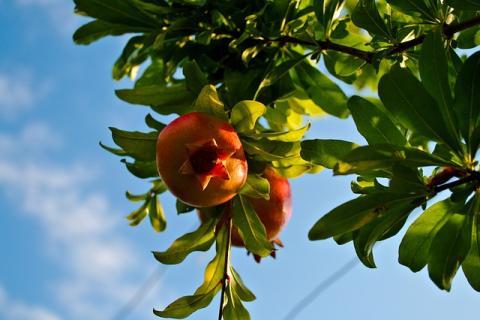
Pomegranate plants are prized for their blooms and fruits; here’s how to get the best out of them…
The good thing about pomegranates is that they are healthy and bursting with antioxidants. The great thing about the plants is that they are hardy and tough and will grow wonderfully well, even in those spots in your garden where nothing else grows. Historically speaking, pomegranates have long been associated with fertility and health and have been mentioned in many ancient Roman aphrodisiac recipes as well.
Pomegranates are full of disease-fighting antioxidants and anti-inflammatory agents. This makes it great for overall health, but specifically great for the heart, in lowering cholesterol, fighting cancers and free radicals, reducing swelling, and providing longevity.
Growing a Pomegranate Plant
Pomegranates can be grown from seed; however, the tree from a seed may not be very reliable – the seed may grow into a hardy plant or one with barely edible fruits. To ensure that the pomegranate tree bears flowers and good fruits, get the right cultivar from your local nursery. Pomegranates can survive cold winters or harsh summers – you just need the right plant for the kind of weather you live in. Common pomegranate cultivars that you can choose from the local nursery include Wonderful, Sweet Pomegranate, Parfianka, Kashmir Blend, Pink Satin, Sharp Velvet, Ambrosia and Angel Red.
General Care
Soil & sun: Pomegranates do well in most soils as long as the soil is well-watered and drained – soggy soils will lead to increased flower and fruit drop. While the plant can survive in partially shaded areas, especially when being pot grown, it thrives in regular sunlight – plant pomegranates just about anywhere in your garden that gets about 2-4 hours of direct sunlight per day.
Watering: The pomegranate plant is drought resistant but will fruit better if you water it in dry conditions every 5-7 days. Soggy soil or too much water is its enemy and will cause flower and fruit drop.
Feeding the pomegranate: A 1:1:1 ratio of NPK fertilizer (Nitrogen, Potassium, and Phosphorus) applied twice a year will ensure good crop and a healthy plant. The application should be done once in spring when the plant starts to bloom and then in winters, when the plant is mostly bare. Additional compost manuring can be done every 2-3 months to improve soil quality that ensures a healthy plant
Shrub or tree: The pomegranate plant can be kept as a shrub of about 10-12 feet or turned into a tree about 20-25 feet high with regular pruning. Either way, as long as your plant is healthy and well-cared for, you will have a good crop about twice a year.
Pests & bugs: The pomegranate plant is hardy but even so is vulnerable to the pomegranate butterfly, leaf-footed bug and the bane of all plants – aphids. While you can go to the local nursery for insecticide in case of a severe infestation, there are natural ways to deal with the same. An insecticidal soap sprayed directly on the insects on a calm sunny day will be effective, as will a homemade oil spray. Mix 6 tablespoons of vegetable oil with ¼ cup of mild dish soap (no fragrance, no de-greaser and no bleach) – add this to two gallons of water (7.5 liters) and thoroughly spray the entire plant with it, including the undersides of the leaf. Another great option is a bacterial insecticide which is nontoxic to us but poisons the bugs and kills them by making the larvae starve.
Fruiting & harvesting: During its first year of growth, the pomegranate plant may or may not produce fruits, and even if it does, the fruits may not be of great quality. Usually it takes 2-3 years for a plant to start producing a good crop. The pomegranate fruits ripen on the tree, they stop ripening the moment they are picked, which is why they last for 5-7 months even after being picked if stored correctly. The first indication of a ripe fruit is the size – depending on the cultivar, a ripe pomegranate is about 2 to 5 inches across. Farmers are also known to tap the fruit – if there’s a metallic sound like a "thunk," the fruit is ready to be picked. To pick the fruit, don’t yank it – instead snip it off at the stem with gardening scissors to avoid damaging the plant.
Easy to grow, healthy to eat and an ingredient of many tasty dishes – the pomegranate plant can indeed be a beautiful addition to your garden. Have any pomegranate growing tips? Please write in to us in the comments section below…








